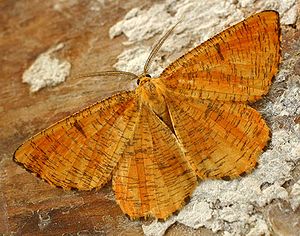Sloe wrench
| Sloe wrench | ||||||||||||
|---|---|---|---|---|---|---|---|---|---|---|---|---|

male |
||||||||||||
| Systematics | ||||||||||||
|
||||||||||||
| Scientific name | ||||||||||||
| Angerona prunaria | ||||||||||||
| ( Linnaeus , 1758) |
The angerona prunaria ( Angerona prunaria ) even plum tensioner called, is a butterfly ( moth ) from the family of the tensioner (Geometridae).
features
The blackthorn is a relatively large and showy representative of his family. The moths reach a wingspan of 35 to 45 millimeters, rarely up to 56 millimeters. The males are usually slightly smaller than the females.
The males of the barnacles have reddish to orange, the females light yellow wings with a fine gray to almost black horizontal line and a cross vein. The fringes at the ends of the veins are darkly spotted. The type is very variable (see shapes).
The caterpillars are also variable in color and look like small dead branches that you can confuse. The body color ranges from a pale yellowish brown to grayish brown to reddish brown. The sides and back are drawn with a series of blackish lines and dots. On the fifth segment there is a pair of small back humps, on segment ten a noticeable pair of back humps can be seen. The head of the caterpillars is brown, they reach a length of up to 50 millimeters.
to form
- Angerona prunaria f. spangbergi Lampa . Dark horizontal lines are missing.
- Angerona prunaria f. corylaria Thunberg . The root and fringing field is darkened olive brown, the middle field remains in the basic color.
- Angerona prunaria f. pickettaria Prout . With remnants of the basic color in the middle field.
- Angerona prunaria f. fuscaria Prout . Solid dark brown wings.
- Angerona prunaria f. pallidaria Prout . Like corylaria , but gray instead of dark brown.
Geographical occurrence and habitat
The sloe moth is widespread throughout Europe and is relatively common in light, bushy forests, gardens and parks. In western and northern Europe the species can be found from France and Ireland to southern Fennoscandia . In the south its distribution area extends from Spain and the northern Mediterranean area over the Balkans , the Black Sea area and Asia Minor to Sakhalin and China ( Jilin ). In Hokkaido (Japan) the species is represented by the subspecies Angerona prunaria turbata Prout.
Way of life
The blackthorn produces a generation a year whose moths fly from late May to mid-August; the moths are rarely found in September. Occasionally a second generation is encountered, but this is incomplete in Germany ( Upper Rhine Plain ). The caterpillars can be found from August. They feed on their forage plants until September or October, overwinter and continue their development until May of the following year. The caterpillars of the blackthorn are polyphagous on various trees, shrubs and herbaceous plants. The following food plants are mentioned in the literature:
|
|
The caterpillars pupate in May in a loose web between leaves. The moths hatch in August, are nocturnal and are often found in the light.
Subspecies
- Angerona prunaria turbata Prout , 1929
- Angerona prunaria dominans Bryk , 1942, Kunashir , Kuril Islands
- Angerona prunaria kentearia Staudinger , 1892, South Siberia
- Angerona prunaria valens Wehrli , 1940, Amur region
The latter two subspecies are also listed as independent species by some authors. Other subspecies established by Bryk Angerona prunaria aquafortis Bryk , 1948 and Angerona prunaria prouterona Bryk , 1948 from Korea and Angerona prunaria mongoligena Bryk , 1948 from Mongolia, have so far received little recognition or are e.g. T. also regarded as independent species.
Individual evidence
- ↑ Bernard Skinner: Color Identification Guide to Moths of the British Isles , Penguin UK 1999, ISBN 0-670-87978-9
- ↑ David J. Carter, Brian Hargreaves: Caterpillars and Butterflies of Europe and their Forage Plants. Blackwell Wissenschaftsverlag 1987, ISBN 3-826-38139-4
- ↑ a b c d e Manfred Koch , Wolfgang Heinicke, Bernd Müller: We determine butterflies. Volume 4: Spanner. 2nd, improved and enlarged edition. Neumann, Leipzig / Radebeul 1976, DNB 780451570 .
- ↑ EA Beljaev: New Data on Geometridae (Lepidoptera) from Sakhalin Iceland. Far Eastern Entomologist, 106: 1-5, September 2001 ISSN 1026-051X PDF
- ↑ Jin Longru, Feng Jiang, Sun Keping, Liu Ying, Wu Lei, Li Zhenxin and Zhang Xichen: Foraging strategies in the greater horseshoe bat (Rhinolophus ferrumequinum) on Lepidoptera in summer. Chinese Science Bulletin, 50 (14): 1477–1482, 2005 doi : 10.1360 / 982004-831 (currently unavailable) , ( doi: 10.1360 / 982004-831 )
- ↑ a b c d e f g h i j k l m n o Günter Ebert (Hrsg.): The butterflies of Baden-Württemberg Volume 9 (Spanner (Geometridae) 2nd part), Nachtfalter VII. Ulmer Verlag Stuttgart 2003. ISBN 3 -800-13279-6
- ↑ a b c d e f g h i j k l m n o p q r s t E. J. Seppänen: Suomen suurperhostoukkien ravintokasvit. Animalia Fennica 14 (1970)
- ↑ Markku Savela: Lepidoptera and some other lifeforms. online (accessed November 1, 2006)
- ↑ a b Naturhistoriska Riksmuseet Stockholm
- ↑ a b S.V.Vasilenko - Ennominae (Geometridae) collection of Siberian Zoological Museum [1]
- ^ Encyclopedia of Life
Web links
- www.lepiforum.de Taxonomy and photos
- www.insektenbox.de
- Ian Kimber: Guide to the moths of Great Britain and Ireland (English)
- Moths and Butterflies of Europe and North Africa (English)
- The Larger Moths of Suffolk (English)
- Angerona prunaria at Fauna Europaea


